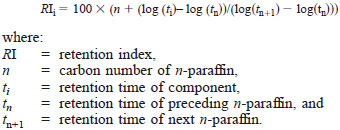ASTM D6730 Standard Test Method for Determination of Individual Components in Spark Ignition Engine Fuels by 100-Metre Capillary (with Precolumn) High-Resolution Gas Chromatography
12. Optimization of Instrument Operating Conditions
12.1 The column temperature programming profile is dependent upon the individual column characteristics. Table 2 lists the programming profile determined for a 100-m methyl silicone column with a precolumn as determined in Annex A1. The profile is determined by establishing satisfactory separations for the sets of sample components listed in 12.3. It is not practical to expect complete separation of all components, so the optimum for each column may contain some compromises, also dependent upon any particular other separations deemed important.
12.2 The use of retention indices to numerically express the relative location of components among themselves and to surrounding normal paraffins is a convenient convention. The indices are also useful in providing a system of component identification with complex analyses such as this. There are several schemes for calculating retention indices, the first of which is the Kovats method, developed to express the logarithmic relationship of retention times of a homologous series of compounds when chromatographed isothermally. While this test method is not an isothermal column temperature procedure, it does contain isothermal steps and the longer temperature program step is a slow rate. The use of the Kovats indices provides a closer relationship to previous work in this field than using the linear index format.
12.2.1 The formula for the calculation of Kovats retention indices is:

12.3 The following examples show the key or critical separations required for this analysis. Typical retention indices are given, and a description of the effect of instrumental conditions on the separation is provided.
12.3.1 i-butane/methanol and ethanol/3-methylbutene-1 - The initial starting temperature of 5°C is dictated by these separations. A lower starting temperature is not necessary and a higher temperature would effect the next set. The retention indices should be about 380 for methanol and 456.5 for ethanol (Fig. 2).
12.3.2 i-propanol/2-methylbutene-1 and t-butanol/2-methylbutene-2-i-propanol will appear resolved between pentene-1 and 2-methyl-butene-1, t-butanol will appear resolved between c-pentene-2 and 2-methylbutene-2.
12.3.2.1 Higher temperatures will move the alcohols into the peaks ahead of them. At 35°C the alcohols will be located ahead of the pentene-1 and c-pentene-2, respectively (Fig. 3).
12.3.3 2,3-dimethylbutane/methyl-t-butylether - This separation is critical and the 5°C hold for 10 min determines its success. The retention indices should be about 569.5, 571.5, and 574.0 for 2,3-dimethylbutane, MTBE, and 2-methylpentane, respectively. If the MTBE is too close to the 2,3-DMC4, use a 9 min initial hold. If too close to the 2-MC5 use an 11 min hold (Fig. 4).
12.3.4 1-methylcyclopentene/benzene - This is a key separation that is used to specify the column selectivity. Changing column temperature produces only slight differences in this resolution (Fig. 5).
12.3.4.1 The 50°C column temperature is held isothermal until the elution of ethylbenzene. This is variable due to slight differences in the column retention factor.
12.3.5 2,3,3-trimethylpentane/toluene - This is a key separation that is used to specify the column selectivity. Column temperature has very little effect on this resolution, which is controlled by the column selectivity for aromatics (Fig. 6).
12.3.6 p-xylene/2,3-dimethylheptane - This is a key separation which limits the maximum length of the precolumn. If the column selectivity is too great the aromatics are retained and this separation is not achieved. If this resolution is excessive and the separation in 12.3.5 is insufficient, the precolumn should be lengthened slightly. Lowering the 50°C hold temperature to 48°C will increase this separation (Fig. 7).
12.3.7 l17 (Unknown)/1,2-methylethylbenzene - The unknown isoparaffin (l17) appears to be a component of alkylate and must be resolved from the aromatic. If the resolution is incomplete the final column temperature program rate of 1.5°/min. is adjusted to provide sufficient separation. Increase the rate in 0.1°/min increments to increase the resolution. This rate is also dictated by the separation requirements in 12.3.8. The proper rate will provide for both separations (Fig. 8).
12.3.8 1-methylnaphthalene/tridecane - The recommended final column temperature program rate of 1.5°/min. should also provide this separation. If the 1-MeNaph/n-C13 resolution is incomplete this rate may be adjusted to provide sufficient separation. Lower the rate in 0.1°/min. increments to increase the resolution (Fig. 9).



